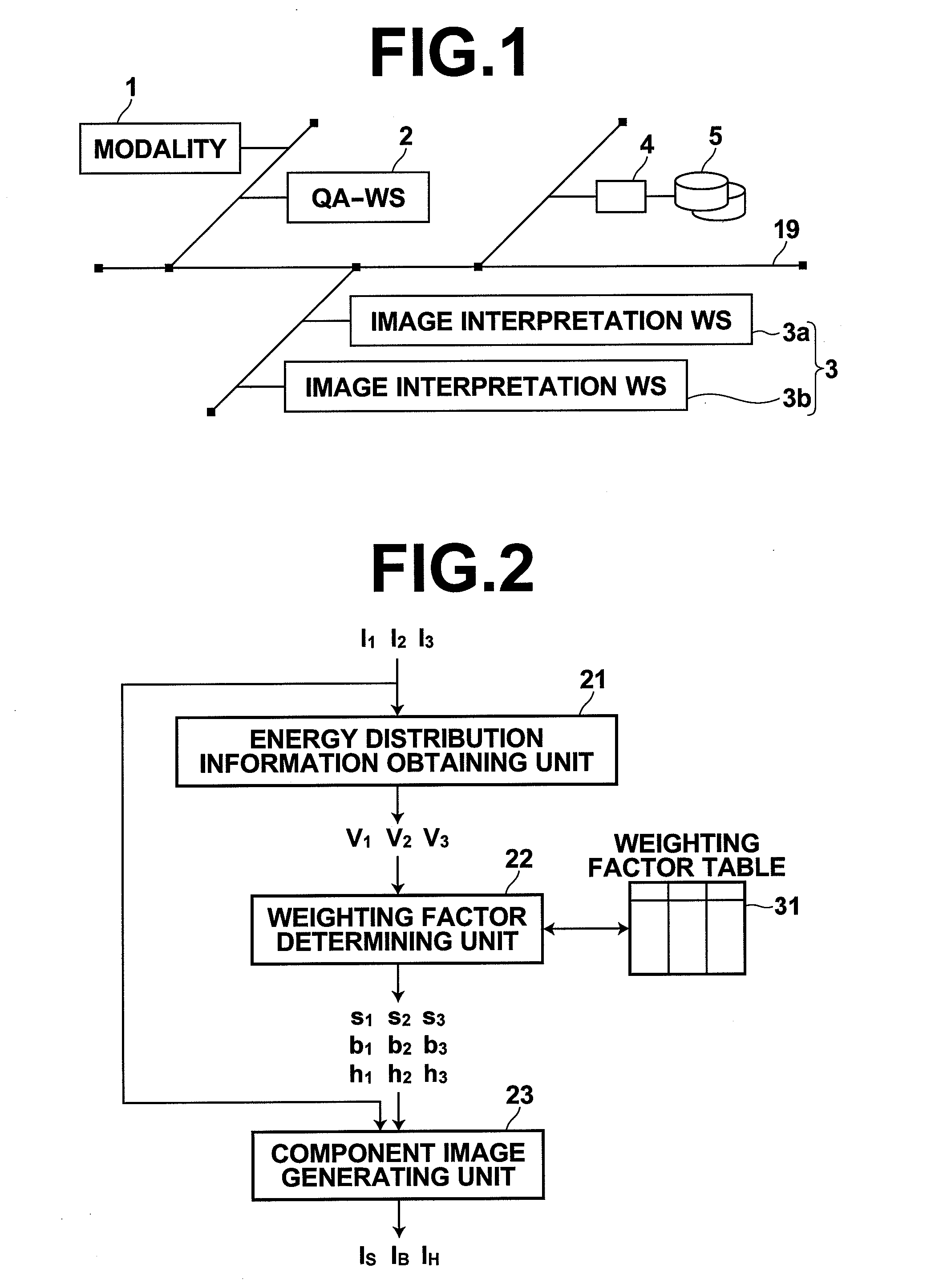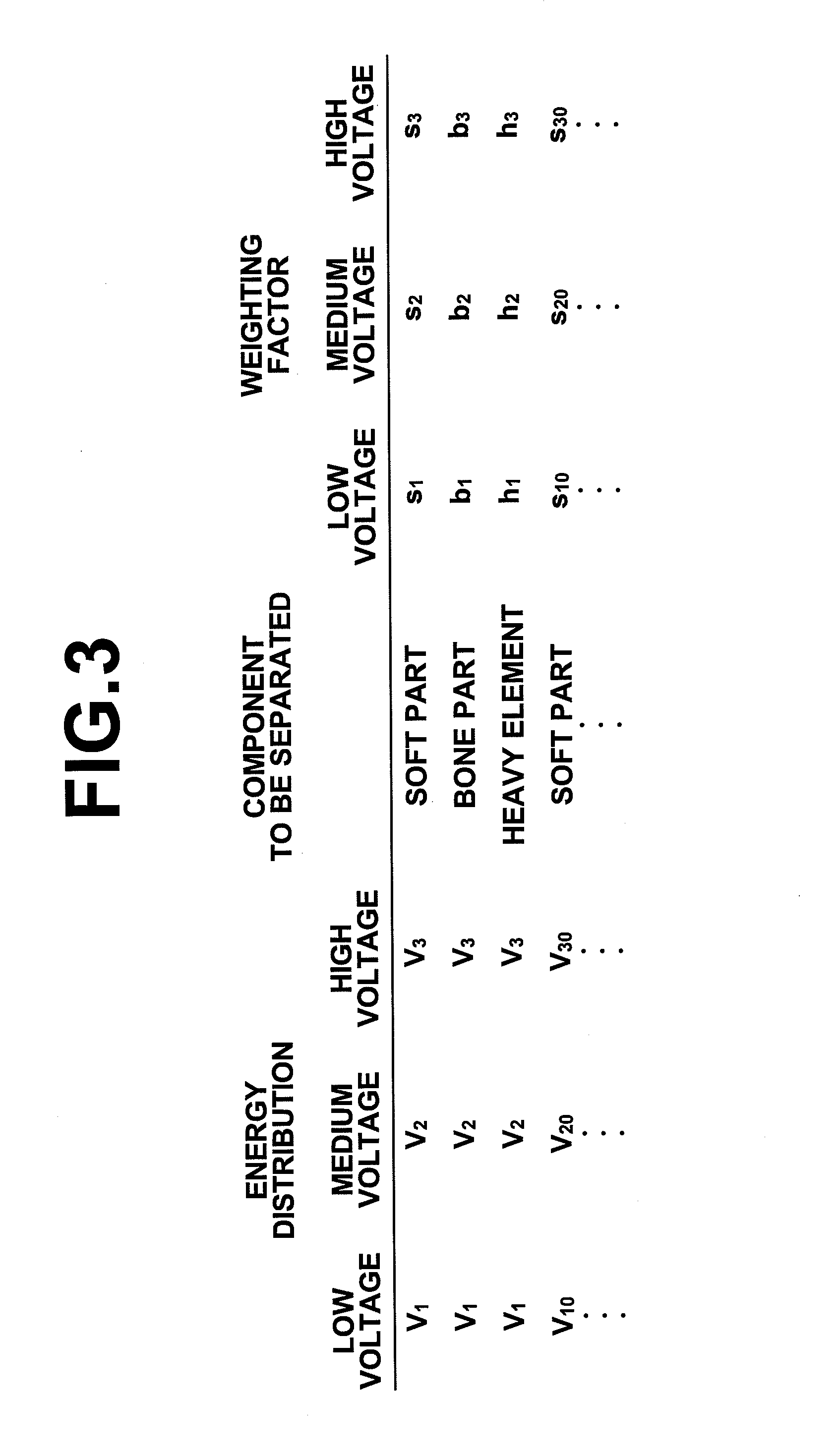Device, method and recording medium containing program for separating image component
a technology of image component and recording medium, which is applied in the field of device, method and recording medium containing program for separating image component, can solve the problems of further separation of the component representing the body tissues into the soft parts
- Summary
- Abstract
- Description
- Claims
- Application Information
AI Technical Summary
Benefits of technology
Problems solved by technology
Method used
Image
Examples
second embodiment
[0088]Therefore, in the invention, a pixel value of each pixel of one of the inputted three radiographic images are used as a parameter, and the above-described weighting factors are determined for each pixel based on this parameter. Specifically, assuming that a pixel value of a pixel p in each inputted image In of each combination of the corresponding pixels is In (p) and the image containing the parameter pixels is I1, weighting factors for the respective components to be separated for each pixel are expressed as sn(I1(p)), bn(I1(p)) and hn(I1(p)), respectively. Using these expressions, a pixel value Is(p), Ib(p) or Ih(p) for each pixel p in each component image is expressed as the following equation (11), (12), (13):
Is(p)=s1(I1(p))·I1(p)+s2(I1(p))·I2(p)+s3(I1(p))·I3(p) (11),
Ib(p)=b1(I1(p))·b1(p)+b2(I1(p))·I2(p)+b3(I1(p))·I3(p) (12),
Ih(p)=h1(I1(p))·I1(p)+h2(I1(p))·I2(p)+h3(I1(p))·I3(p) (13).
[0089]It should be noted that the image of the parameter pixels may be I2 or I3, and...
first embodiment
[0090]An example of implementation of these equations is described below. First, as shown in FIG. 6, an item (“pixel value from / to”) indicating ranges of pixel values of the parameter image I1 is added to the weighting factor table 31 in the first embodiment, so that a weighting factor for each pixel of each image can be set for each energy distribution information of the image, for each component to be separated and for each pixel value range of the pixel in the image I1 of the corresponding pixels. In the example shown in FIG. 6, assuming that the energy distribution information, i.e., the tube voltages of the three inputted images are V1, V2 and V3, and the component to be separated is the soft part component, the weighting factors for the respective inputted images are: s11, s12 and s13 if the pixel value of the image I1 is equal to or more than p1 and less than p2; s21, s22 and s23 if the pixel value of the image I1 is equal to or more than p2 and less than p3; and s31, s32 and...
third embodiment
[0093]Next, the invention will be described, in which the weighting factors are indirectly obtained. In this embodiment, a model using attenuation coefficients for the respective components in the above equations (1), (2) and (3) is used. As shown in FIG. 8, the attenuation coefficient monotonically decreases as the energy distribution (tube voltage) of the radiation for each image increases, and increases as the atomic number of the component increases.
[0094]FIG. 7 is a block diagram schematically illustrating the functional configuration and data flow of the image component separating device of this embodiment. As shown in the drawing, the difference between this embodiment and the first and second embodiments lies in that an attenuation coefficient determining unit 24 is added and the weighting factor table 31 is replaced with an attenuation coefficient table 32.
[0095]The attenuation coefficient determining unit 24 references the attenuation coefficient table 32 with the energy d...
PUM
 Login to View More
Login to View More Abstract
Description
Claims
Application Information
 Login to View More
Login to View More - R&D
- Intellectual Property
- Life Sciences
- Materials
- Tech Scout
- Unparalleled Data Quality
- Higher Quality Content
- 60% Fewer Hallucinations
Browse by: Latest US Patents, China's latest patents, Technical Efficacy Thesaurus, Application Domain, Technology Topic, Popular Technical Reports.
© 2025 PatSnap. All rights reserved.Legal|Privacy policy|Modern Slavery Act Transparency Statement|Sitemap|About US| Contact US: help@patsnap.com



